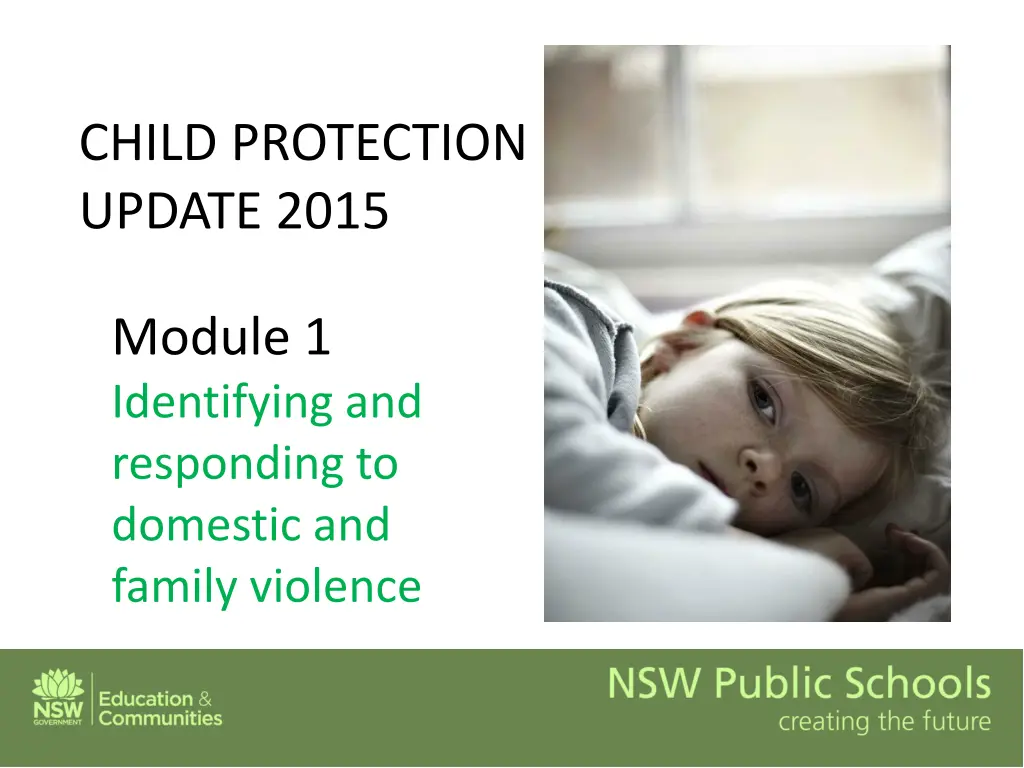
Identifying and Responding to Domestic and Family Violence in NSW 2015
Explore the Child Protection Update 2015 Module 1, focusing on identifying and responding to domestic and family violence in children and young people. Learn about the new directions in NSW, staff roles in follow-up support, the NSW plan to end domestic violence, new strategies under the "It Stops Here" initiative, and behaviors constituting domestic violence. Enhance your awareness to provide appropriate responses and support to those affected.
Download Presentation

Please find below an Image/Link to download the presentation.
The content on the website is provided AS IS for your information and personal use only. It may not be sold, licensed, or shared on other websites without obtaining consent from the author. If you encounter any issues during the download, it is possible that the publisher has removed the file from their server.
You are allowed to download the files provided on this website for personal or commercial use, subject to the condition that they are used lawfully. All files are the property of their respective owners.
The content on the website is provided AS IS for your information and personal use only. It may not be sold, licensed, or shared on other websites without obtaining consent from the author.
E N D
Presentation Transcript
CHILD PROTECTION UPDATE 2015 Module 1 Identifying and responding to domestic and family violence
Session outline This session includes information on: new directions in NSW for domestic and family violence indicators in children and young people of possible exposure appropriate responses to safety, welfare and wellbeing concerns for those children and young people staff roles in follow up support. 2
The new NSW plan It stops here: Standing Together to end domestic and family violence In 2014 the NSW government made a commitment to improving the response to domestic and family violence by all organisations, including schools, through: increased collaboration integrated service provision improved information sharing. 3
New strategies under It Stops Here a common Domestic Violence Safety Assessment Tool (not for Education staff who will continue to use the Mandatory Reporter Guide) Central Referral Point for electronic referrals state-wide Local Coordination Points Safety Action Meetings interagency meetings to discuss local victims at serious threat additional information sharing provisions. 4
Domestic and family violence Domestic and family violence includes any behaviour, in an intimate or family relationship, which is violent, threatening, coercive or controlling, causing a person to live in fear. It is usually manifested as part of a pattern of controlling or coercive behaviour. It Stops Here- Standing together to end domestic and family violence (NSW 2014) 5
Behaviours that may constitute domestic and family violence: physical violence sexually abusive or coercive behaviour emotional or psychological abuse including verbal abuse and threats of violence economic abuse harassment, intimidation or coercion of the other person s family (continued) 6
Behaviours that may constitute domestic and family violence: (continued) deprivation of liberty preventing the other person from making or keeping connections with her or his family or kin, friends, faith or culture damaging property hurting family pets or animals. 7
Domestic violence-related assaults recorded by NSW Police Force In NSW during the 12 months prior to September 2012 there were: 20,709 female victims and 9,199 male victims 11% of female victims were aged 0-17 years 18% of male victims were aged 0-17 years. 8 NSW Bureau of Crime Statistics and Research (BOSCAR)
How many children and young people are affected by child abuse in NSW? Reports to Family and Community Services Helpline in 2012/13 246, 173 reports of concern representing 103,645 children and young people. 104,817 were risk of significant harm representing 64,470 children and young people. 9 Community Services Annual Statistical Report 2012/13
Reports to Family and Community Services Helpline in 2012/13 10 Community Services Annual Statistical Report 2012/13
Children living with violence are at increased risk of a range of negative outcomes including: depression anxiety post-traumatic stress symptoms interpersonal problems developmental problems behavioural problems. 11
Brainstorm: What are some behaviours of children in our school that may indicate they are exposed to, or are experiencing, domestic and family violence? Primary schools 12
Brainstorm: What are some behaviours of children and young people in our school that may indicate they are exposed to, or are experiencing, domestic and family violence? Secondary schools 13
Case study Part 1 14
Case study Part 2 15
Why doesnt she just leave? It would seem a simple solution to leave an abusive relationship however this does not take into account the complexity of issues women may face. What could be some issues Pamela may need to deal with if she ended her relationship with Bob? 16
Impact of domestic violence on parenting a parent s confidence, authority and relationship with their children being undermined. real and perceived parenting capacity being diminished staying in a relationship as they feel their children would be better off in the family unit. 17
What would our school do to support the children if they attended our school? Secondary schools: Robert Primary schools: Mary and Jess 18
Ongoing staff roles: providing support to students monitoring, such as observing the child or young person s relationships with others, taking note of any patterns of behaviour, noting patterns of absences asking how things are going at home continuing to identify, respond to, or inform the principal of further concerns. 19
Resources It Stops Here- Standing together to end domestic and family violence (NSW 2014) Working with families where an adult is violent, Department of Human Services, Victoria, 2014 Family Referral Services Local domestic violence network/s Local Council 20
